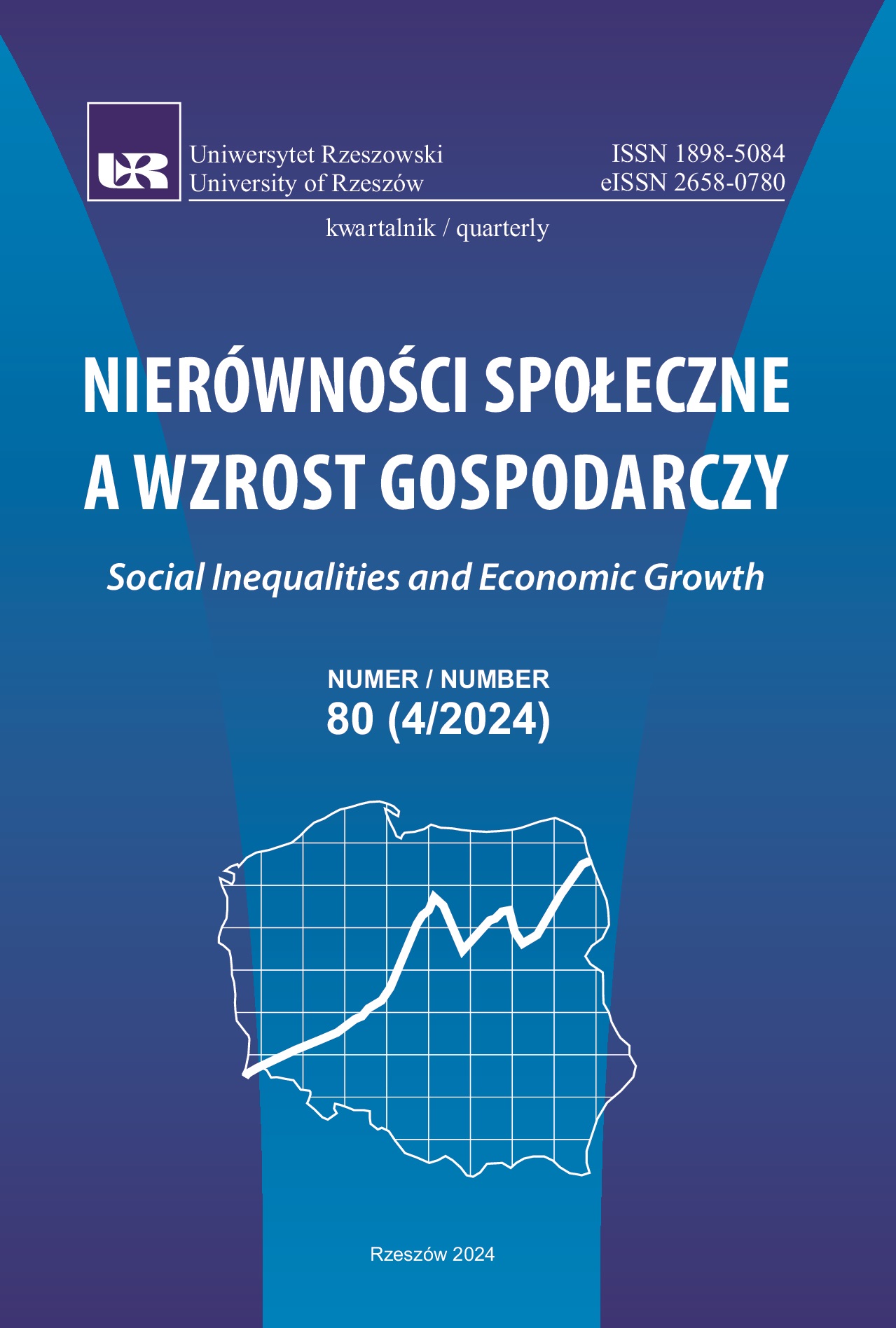System emerytalny Stanów Zjednoczonych a teoria ekonomii
DOI:
https://doi.org/10.15584/nsawg.2024.4.5Słowa kluczowe:
system emerytalny, Social Security, 401(k), teoria ekonomii, redystrybucja zasobów, ekonomia dobrobytuAbstrakt
Celem artykułu jest analiza systemu emerytalnego Stanów Zjednoczonych w kontekście teorii ekonomii, w tym teorii redystrybucji zasobów, ekonomii dobrobytu oraz modeli pokoleń nakładających się (OLG). System ten, oparty na publicznym ubezpieczeniu społecznym (Social Security) oraz prywatnych planach oszczędnościowych, takich jak 401(k) i IRA, stanowi przykład zróżnicowanego podejścia do zabezpieczenia emerytalnego. Przeprowadzona analiza wskazuje, że połączenie elementów repartycyjnych i kapitałowych umożliwia większą elastyczność i efektywność w dostosowywaniu systemu do zmieniających się warunków demograficznych i gospodarczych.
Wyniki badań wskazują, że Social Security odgrywa kluczową rolę w zapewnianiu podstawowego dochodu emerytalnego, wspierając cele społeczne i redystrybucyjne, podczas gdy prywatne plany oszczędnościowe promują indywidualną odpowiedzialność i efektywną alokację zasobów. W kontekście teorii ekonomii dobrobytu oraz modeli OLG systemy kapitałowe są bardziej efektywne w gospodarkach, gdzie rynkowe stopy procentowe przewyższają stopy wzrostu populacji. Jednak prywatne mechanizmy oszczędzania niosą ze sobą ryzyko związane z wahaniami rynków finansowych, co wymaga dodatkowych regulacji i wsparcia edukacyjnego.
W artykule wskazano na znaczenie elastyczności systemu emerytalnego w obliczu wyzwań związanych ze starzeniem się ludności oraz zmieniającymi się warunkami ekonomicznymi. Amerykański system emerytalny może stanowić inspirację do dalszych badań nad efektywnością różnych mechanizmów finansowych w kontekście ich wpływu na stabilność finansową i dobrobyt społeczny.
Downloads
Bibliografia
Abel, A., Mankiw, N., Summers, L., Zeckhauser, R. (1989). Assessing dynamic efficiency: Theory and evidence. Review of Economic Studies, 56(1), 1–19.
Achenbaum, W.A. (1986). Social Security: Visions and Revisions. Cambridge: Cambridge University Press.
Allais, M. (1947), Économie et intérêt. Paris: Imprimerie Nationale.
Blake, D. (2006). Pension economics. Chichester: John Wiley & Sons.
Blanchard, O. (1985). Debts, deficits, and finite horizons. Journal of Political Economy, 93(2), 223–247.
Breyer, F. (1989). On the intergenerational Pareto efficiency of pay-as-you-go financed pension systems. Journal of Institutional and Theoretical Economics, 145, 643–658.
Diamond, P. (1965). National debt in a neoclassical growth model. American Economic Review, 55(5), 1126–1150.
Federal Reserve. Historical data on treasury bond yields. Pobrane z: https://www.federalreserve.gov (2025.01.12).
Fisher, I. (1930). The Theory of Interest. New York: Macmillan.
Holden, S., Schrass, D. (2023). 401(k) Plan Asset Allocation, Account Balances, and Loan Activity. Washington, D.C.: Investment Company Institute.
Independent Directors Council (IDC). (2024). Quarterly Retirement Market Data, First Quarter 2024. Pobrane z: https://www.idc.org/ (2024.09.13).
Internal Revenue Service (IRSa). 401(k) Resource Guide – Plan Sponsors – General Distribution Rules. Pobrane z: https://www.irs.gov/retirement-plans/401k-resource-guide-plan-sponsors-general-distribution-rules (2024.09.13).
Internal Revenue Service (IRSb). Individual Retirement Arrangements (IRAs). Pobrane z: https://www.irs.gov/retirement-plans/individual-retirement-arrangements-iras (2024.09.13).
Komisja Nadzoru Ubezpieczeń i Funduszy Emerytalnych. (2003). Reformy systemu emerytalnego w USA. Biuletyn Miesięczny, 5(46), 1–2.
Legal Information Institute. 28 U.S. Code § 371 – Retirement on salary; retirement in senior status. Pobrane z: https://www.law.cornell.edu/uscode/text/28/371 (2024.09.13).
List With Clever. (2024). Retirement statistics in 2024: U.S. retirees in crisis. Pobrane z: https://www.listwithclever.com/ (2024.09.13).
Madrian, B.C., Shea, D.F. (2001). The power of suggestion: Inertia in 401(k) participation and savings behavior. The Quarterly Journal of Economics, 116(4), 1149–1187. DOI: 10.1162/003355301753265543.
Munnell, A.H., Sundén, A. (2004). Coming up short: The challenge of 401(k) plans. Washington, D.C.: Brookings Institution Press.
National Association of State Retirement Administrators (NASRA). National Association of State Retirement Administrators. Pobrane z: https://www.nasra.org/ (2024.09.13).
National Law Review. (2024). Important changes affecting retirement plans in 2024. Pobrane z: https://www.natlawreview.com/ (2024.09.13).
OECD. (2023). Pensions at a Glance 2023: OECD and G20 Indicators. OECD Publishing, Paris. Pobrane z: https://www.oecd.org/en/publications/pensions-at-a-glance-2023_678055dd-en.html (2025.01.12).
Pension Benefit Guaranty Corporation (PBGC). About PBGC. Pobrane z: https://www.pbgc.gov/about (2024.09.13).
Pigou, A.C. (1920). The economics of welfare. London: Macmillan.
Samuelson, P.A. (1958). An exact consumption-loan model of interest with or without the social contrivance of money. Journal of Political Economy, 66(6), 467–482.
Social Security Administration (SSA). (2022). Annual Report of the Board of Trustees of the Federal Old-Age and Survivors Insurance and Federal Disability Insurance Trust Funds. Washington, DC, SSA
Social Security Administration (SSAa). Key Dates in the History of Social Security. Pobrane z: https://www.ssa.gov/history (2024.09.13).
Social Security Administration (SSAb). FICA & SECA Tax Rates. Pobrane z: https://www.ssa.gov (2024.09.13).
U.S. Census Bureau. (2020). Annual population estimates. Pobrane z: https://www.census.gov (2025.01.12).
U.S. Department of Defense. Military Compensation – Retirement. Pobrane z: https://militarypay.defense.gov/ (2024.09.13).
U.S. Department of Labor, Employee Benefits Security Administration (EBSAb). Employee Retirement Income Security Act (ERISA). Pobrane z: https://www.dol.gov/agencies/ebsa/about-ebsa/our-activities/resource-center/fact-sheets/what-is-erisa (2024.09.13).
U.S. Department of Labor, Employee Benefits Security Administration (EBSAa). History of 401(k) plans: An update. Pobrane z: https://www.dol.gov/agencies/ebsa/about-ebsa/our-activities/resource-center/publications/history-of-401k (2024.09.13).
U.S. Office of Personnel Management (OPM). Federal Employees Retirement System (FERS) Handbook. Pobrane z: https://www.opm.gov/retirement-services/fers-information/ (2024.09.13).
Yaari, M.E. (1965). Uncertain lifetime, life insurance, and the theory of the consumer. Review of Economic Studies, 32(2), 137–150. DOI: 10.2307/2296058.
Pobrania
Opublikowane
Jak cytować
Numer
Dział
Licencja
Prawa autorskie (c) 2025 Uniwersytet Rzeszowski

Utwór dostępny jest na licencji Creative Commons Uznanie autorstwa – Użycie niekomercyjne – Bez utworów zależnych 4.0 Międzynarodowe.


